2021年中考英语---完形填空课件26张
文档属性
| 名称 | 2021年中考英语---完形填空课件26张 |  | |
| 格式 | zip | ||
| 文件大小 | 224.2KB | ||
| 资源类型 | 教案 | ||
| 版本资源 | 通用版 | ||
| 科目 | 英语 | ||
| 更新时间 | 2021-04-12 20:30:14 | ||
图片预览

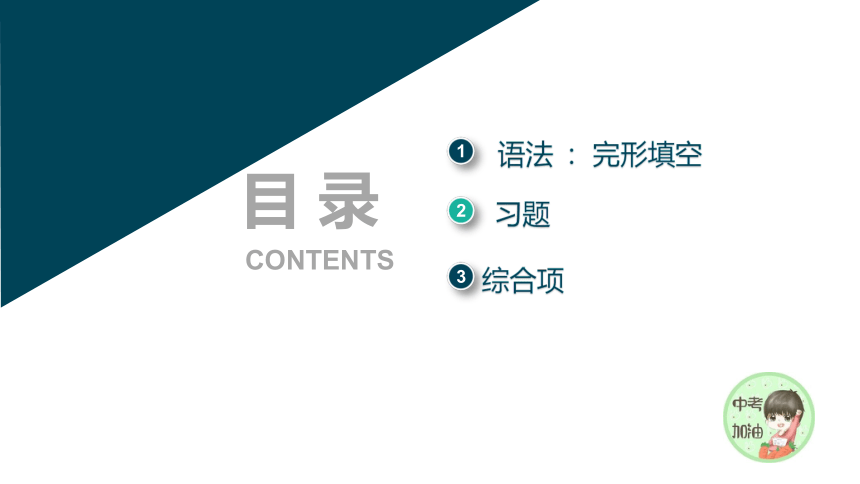

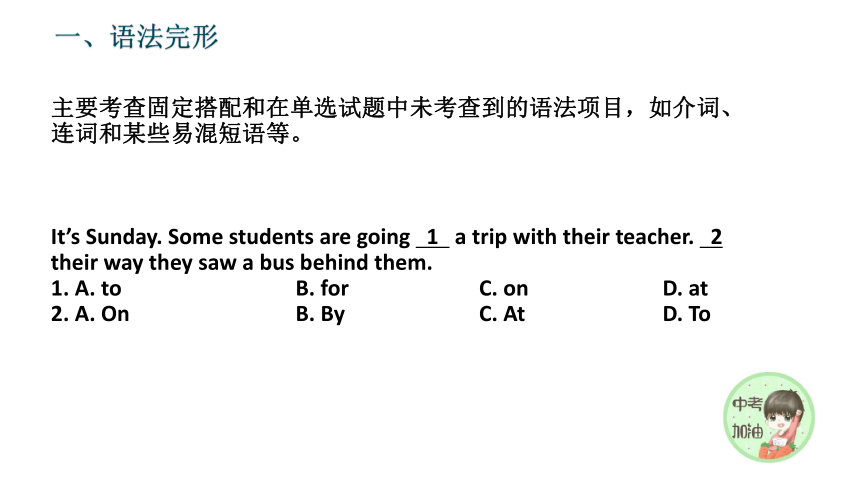
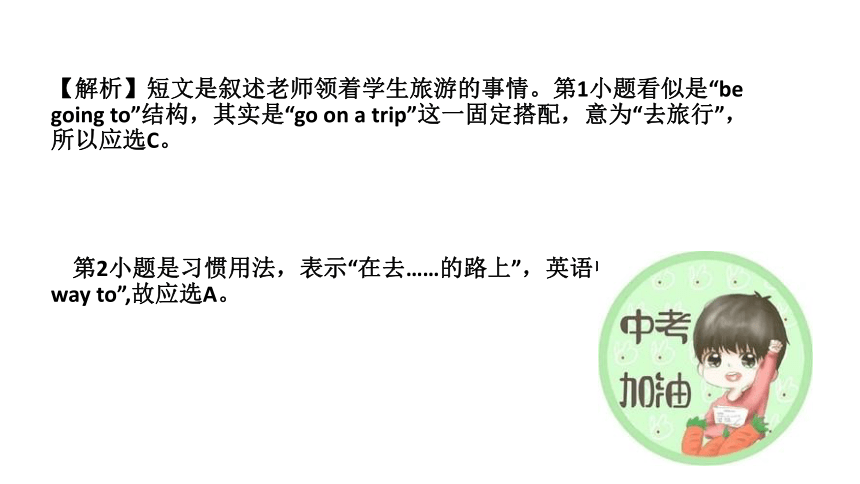
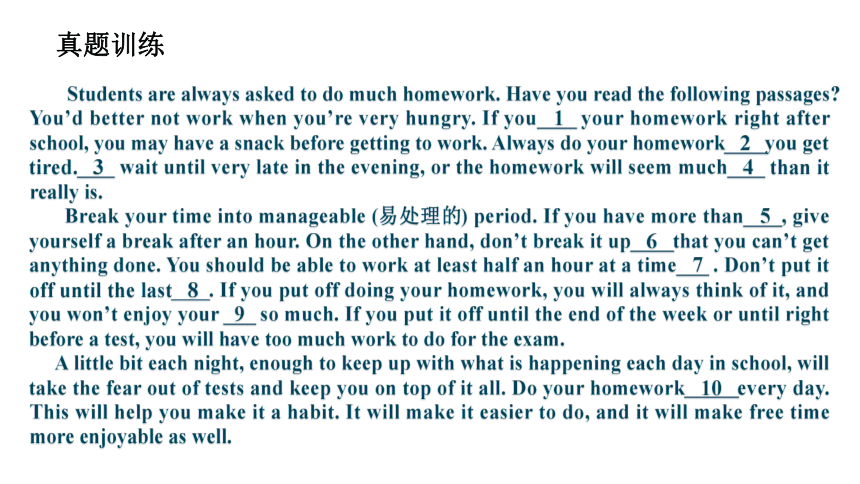
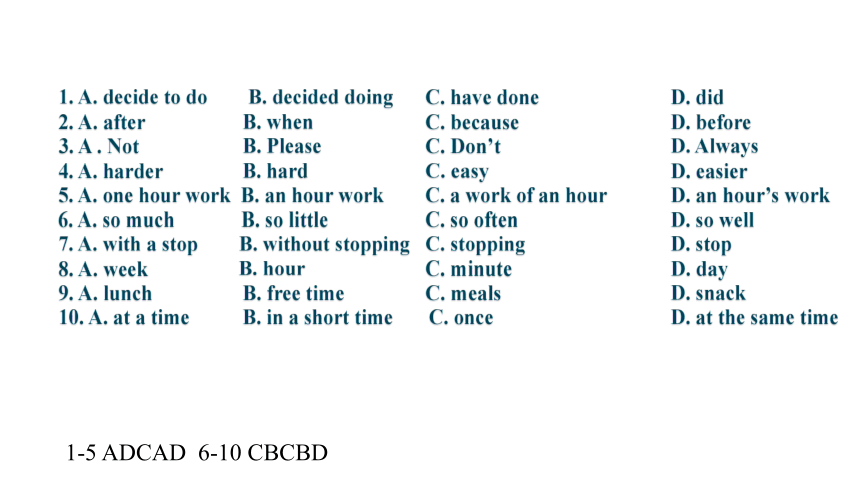

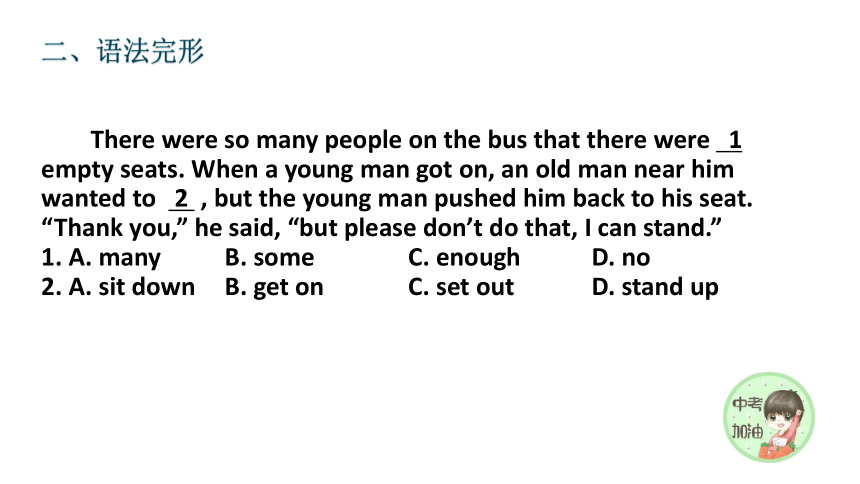
文档简介
(共26张PPT)
完形填空
1
语法
:完形填空
2
习题
3
综合项
目
录
CONTENTS
一、语法完形
主要考查固定搭配和在单选试题中未考查到的语法项目,如介词、连词和某些易混短语等。
It’s
Sunday.
Some
students
are
going
1
a
trip
with
their
teacher.
2
their
way
they
saw
a
bus
behind
them.
1.
A.
to
B.
for
C.
on
D.
at
2.
A.
On
B.
By
C.
At
D.
To
【解析】短文是叙述老师领着学生旅游的事情。第1小题看似是“be
going
to”结构,其实是“go
on
a
trip”这一固定搭配,意为“去旅行”,所以应选C。
第2小题是习惯用法,表示“在去……的路上”,英语中要用“on
one’s
way
to”,故应选A。
Students
are
always
asked
to
do
much
homework.
Have
you
read
the
following
passages?
You’d
better
not
work
when
you’re
very
hungry.
If
you
1
your
homework
right
after
school,
you
may
have
a
snack
before
getting
to
work.
Always
do
your
homework
2
you
get
tired.
3
wait
until
very
late
in
the
evening,
or
the
homework
will
seem
much
4
than
it
really
is.
Break
your
time
into
manageable
(易处理的)
period.
If
you
have
more
than
5
,
give
yourself
a
break
after
an
hour.
On
the
other
hand,
don’t
break
it
up
6
that
you
can’t
get
anything
done.
You
should
be
able
to
work
at
least
half
an
hour
at
a
time
7
.
Don’t
put
it
off
until
the
last
8
.
If
you
put
off
doing
your
homework,
you
will
always
think
of
it,
and
you
won’t
enjoy
your
9
so
much.
If
you
put
it
off
until
the
end
of
the
week
or
until
right
before
a
test,
you
will
have
too
much
work
to
do
for
the
exam.
A
little
bit
each
night,
enough
to
keep
up
with
what
is
happening
each
day
in
school,
will
take
the
fear
out
of
tests
and
keep
you
on
top
of
it
all.
Do
your
homework
10
every
day.
This
will
help
you
make
it
a
habit.
It
will
make
it
easier
to
do,
and
it
will
make
free
time
more
enjoyable
as
well.
真题训练
1.
A.
decide
to
do
B.
decided
doing
C.
have
done
D.
did
2.
A.
after
B.
when
C.
because
D.
before
3.
A
.
Not
B.
Please
C.
Don’t
D.
Always
4.
A.
harder
B.
hard
C.
easy
D.
easier
5.
A.
one
hour
work
B.
an
hour
work
C.
a
work
of
an
hour
D.
an
hour’s
work
6.
A.
so
much
B.
so
little
C.
so
often
D.
so
well
7.
A.
with
a
stop
B.
without
stopping
C.
stopping
D.
stop
8.
A.
week
B.
hour
C.
minute
D.
day
9.
A.
lunch
B.
free
time
C.
meals
D.
snack
10.
A.
at
a
time
B.
in
a
short
time
C.
once
D.
at
the
same
time
1-5
ADCAD
6-10
CBCBD
二、语法完形
意义完形主要侧重于对语言应用能力的考查,更加注重对语篇的理解。如果只看单个的句子,有时所提供的四个选项从语法角度来看都讲得通,但是在具体的语篇中只能有一个正确答案。因此,看一空做一空的做法是不可取的,必须从语篇的角度来考虑所选答案。做题时一定要联系上下文,从字里行间寻找隐藏信息,同时要根据四个选项的设置特点来进行选择。
二、语法完形
There
were
so
many
people
on
the
bus
that
there
were
1
empty
seats.
When
a
young
man
got
on,
an
old
man
near
him
wanted
to
2
,
but
the
young
man
pushed
him
back
to
his
seat.
“Thank
you,”
he
said,
“but
please
don’t
do
that,
I
can
stand.”
1.
A.
many
B.
some
C.
enough
D.
no
2.
A.
sit
down
B.
get
on
C.
set
out
D.
stand
up
【解析】第1小题所给的选项是四个限定词,单就语法来看它们均可和后面的empty
seats搭配。但根据上文的“There
were
so
many
people
on
the
bus...”来判断,不可能有许多(many)、一些(some)、足够的(enough)“空位”。因此,该题的正确答案为D。
第2小题所给的四个选项是四个动词短语,根据下文的
“...
pushed
him
back
to
his
seat”
和
“I
can
stand”来看,年轻人误认为老人要给他让座,而实际上是老人是想站起来下车,所以,该题的正确答案为D。
“Problems
and
worries
are
normal
in
life,”
says
Laura.
“But
I
think
talking
to
someone
helps
a
lot.
If
we
don’t
talk
to
someone,
we’ll
certainly
feel
1
.”
Laura
once
lost
her
2
,
and
worried
for
days.
She
was
afraid
to
tell
her
parents
about
it.
She
even
walked
three
miles
to
school
each
day
because
she
didn’t
have
any
money.
She
just
kept
3
of
the
problem
again
and
again
in
her
mind.
“If
I
tell
my
parents,
they’ll
be
angry!”
But
in
the
end,
she
talked
to
her
parents
and
they
were
really
4
.
Her
dad
said
he
5
made
careless
mistakes
himself.
They
got
her
a
new
wallet
and
asked
her
to
be
more
careful.
“I
will
always
remember
to
6
my
problems
in
the
future!”
Laura
says.
Robert
Hunt
advises
students
about
common
7
.
He
feels
the
same
way
as
Laura.
“It
is
best
not
to
avoid
our
problems.
We
should
always
try
to
solve
(解决)
them.”
He
thinks
that
you
can
first
find
someone
to
talk
to.
This
person
doesn’t
need
to
be
an
expert
(专家)
like
himself.
Students
often
forget
that
their
parents
have
more
8
than
them,
and
are
always
there
to
9
them.
In
English,
we
say
that
sharing
a
problem
is
like
cutting
it
in
half.
So
you’re
halfway
to
solving
a
problem
if
you
talk
to
10
about
it!
真题训练
1.
A.
better
B.
happier
C.
worse
D.
cleverer
2.
A.
wallet
B.
bike
C.
money
D.
phone
3.
A.
hoping
B.
thinking
C.
wishing
D.
expecting
4.
A.
seeing
B.
knowing
C.
learning
D.
understanding
5.
A.
sometimes
B.
always
C.
never
D.
seldom
6.
A.
cover
B.
share
C.
guess
D.
stop
7.
A.
questions
B.
answers
C.
ideas
D.
problems
8.
A.
friendship
B.
love
C.
truth
D.
experience
9.
A.
help
B.
beat
C.
hurt
D.
fail
10.
A.
none
B.
someone
C.
each
D.
no
one
1-5
CABDA
6-10
BDDAB
要点三
完型填空正确解题技巧
(一)快速浏览抓大意
先快速地浏览全文,以便对文章有全面的了解,抓住文章的大意。切忌为了节省时间一开始就忙于见空就填,否则只会欲速则不达。见空就填势必无法从整体上把握文章的脉络,无法形成连贯的思路,理解就会偏离文章的中心,造成顾此失彼的错误。
浏览全文的目的是抓住文章大意,其速度一定要快。如果遇到个别生词或难懂的句子,要么通过上下文猜测其意,要么暂时跳过,不必进行字斟句酌的精读。抓住了文章的大意后,围绕文章大意去阅读、预测、判断,往往会收到事半功倍的效果。
(二)扣大意做易题
通过快速浏览抓住文章的大意后,就可以开始逐句精读短文,逐题分析选项,克服“思维定式”,根据全文大意和词不离句、句不离文的原则,逐项填空。
做题时要善于发现和利用文中没有留空的句子,从字里行间寻找隐藏信息。
做题时要遵循先易后难的原则,先把有把握的题选定,对于没有把握的题可暂时跳过,先做后面的题。等填完有把握的空后,再回头来做前面的“难”题。如此反复,各个击破。
(三)仔细推敲攻难关
一些难题在设空时设置得比较巧妙,四个选项从语法角度或习惯搭配来看都行得通。对于这样的题应从全篇文章内容上考虑,结合文章的整体内容加以分析、仔细推敲,选出文章特定的情景中所需要的那个选项,由于有把握的空已设定,文章又多了许多有效信息,这时难题也就容易了。
(四)复读全文纠失误
对填完空的短文应从头至尾再读一遍。根据复读的语感和对整篇短文的理解,再次将较明显的错误改正,个别需要推敲的再作调整,力争少出错。
The
world
needs
love
and
many
people
need
our
help.
Several
years
ago,
my
teachers
asked
me
to
take
part
in
a
program
that
helps
those
who
are
1
.
Each
week,
I
spend
an
hour
in
the
classroom
helping
children
with
schoolwork,
art
projects,
games
and
other
2
,
including
eating.
My
mother
is
a
teacher,
so
I
am
used
to
helping
children;
however,
I
found
that
working
with
children
with
special
needs
would
3
my
life
forever.
At
first,
I
thought
it
would
be
4
to
be
with
the
children
who
are
so
different,
but
gradually
I
found
there’s
something
special
about
these
students.
So
there
was
no
need
to
worry
about
it.
Each
Thursday
I
was
welcomed
by
the
smiling
faces
of
Thomas,
Joey
and
Missy.
Thomas
has
to
sit
on
the
wheelchair.
He
communicates
with
simple
words
5
yes
or
no.
Joey,
a
deaf
girl,
always
welcomed
me
with
a
big
smile.
Missy
was
born
with
a
kind
of
6
and
it
makes
her
really
small
for
her
age.
In
a
normal
classroom,
it
would
be
common
to
hear
a
teacher
comfort
a
child
who
is
tapping
his
pencil,
speaking
7
,
or
making
unnecessary
noises.
However,
here,
shouts,
cries,
and
other
noises
are
8
.
They’re
signs
of
excitement
and
different
ways
of
communicating.
Working
with
children
with
special
needs
has
changed
my
life.
It
has
made
me
9
others’
needs.
One
of
my
teachers
believes
that
we
should
be
part
of
something
bigger
than
10
.
I
never
realized
how
true
this
was
until
I
worked
with
these
children.
I
believe
everyone
should
get
out
and
do
something
that
makes
a
difference.
真题训练
1.
A.
uneducated
B.
homeless
C.
disabled
2.
A.
courses
B.
competitions
C.
activities
3.
A.
change
B.
waste
C.
save
4.
A.
nervous
B.
relaxing
C.
lively
5.
A.
except
B.
like
C.
against
6.
A.
ability
B.
illness
C.
habit
7.
A.
clearly
B.
politely
C.
loudly
8.
A.
mentioned
B.
stopped
C.
encouraged
9.
A.
refuse
B.
notice
C.
influence
10.
A.
ourselves
B.
yourselves
C.
themselves
1-5
CCAAB
6-10
BCCBA
方法技巧
1.重视首句,把握开篇
细读首句,可判断文章体裁。把握文章的主旨大意和作者的写作意图,利用它作为解题的突破口。
2.快速通读全文,掌握大意,利用语境关系解题。
3.利用复现关系解题
复现指的是某一词以原词、同义词、近义词或反义词的形式出现在上下语篇中,语篇中的句子通过这种复现关系得到相互衔接,使整篇文章上下连贯。
4.把握上下文的内在联系,确定最佳选项
5.利用固定搭配和习惯用语解题
6.利用上下文逻辑关系解题
7.利用关键词解题
8.利用语法分析解题
不仅要理解上下文的逻辑关系,更要针对性的对语法结构、句式特点、对短文中所设空格中需填的词在句子中作何成分、哪类词合适、应采取什么形式等进行必要的分析思考。
9.利用文化背景知识和生活常识解题
Many
of
us
enjoy
watching
animals
in
the
world.
But
do
you
know
they
can
teach
us?
Geese
(雁),
for
example,
teach
a
very
good
lesson
about
1
.
In
the
fall,
Canada
geese
fly
to
the
warm
south
to
2
Canada’s
cold
winter.
They
lift
off
in
no
order.
Yet
3
they
form
a
V
shape,
with
one
bird
leading
the
group.
This
V
shape
allows
geese
to
4
energy.
When
the
front
bird
moves
its
wings
up
and
down,
the
resulting
force
of
the
air
lifts
the
next
one.
This
continues
down
the
line.
The
bird
5
has
the
hardest
job.
When
it
gets
6
,
it
moves
behind,
and
another
bird
moves
into
the
lead.
By
sharing
the
role,
the
group
can
travel
great
distances.
Geese
flying
in
a
V
shape
can
fly
70
percent
farther
without
7
than
birds
flying
alone.
During
the
long
flying
journey,
geese
communicate
with
one
another.
They
honk
(鸣叫)
to
8
the
birds
up
front
to
keep
up
the
speed.
They
also
cheer
each
other
up
9
working
toward
a
common
goal.
What
have
we
learned
from
the
lovely
geese’s
experience
and
skills?
10
together!
Whether
it
is
our
personal
lives
or
our
jobs,
we
need
other
people.
We
need
the
spirit
of
teamwork!
真题训练
1.
A.
experience
B.
success
C.
friendship
D.
teamwork
2.
A.
look
for
B.
get
away
from
C.
wait
for
D.
walk
away
from
3.
A.
busily
B.
quickly
C.
bravely
D.
suddenly
4.
A.
save
B.
waste
C.
create
D.
lose
5.
A.
in
front
B.
at
the
back
C.
in
the
middle
D.
on
the
left
6.
A.
bored
B.
tired
C.
hungry
D.
thirsty
7.
A.
rest
B.
sleep
C.
excuse
D.
result
8.
A.
lead
B.
lift
C.
teach
D.
encourage
9.
A.
until
B.
after
C.
while
D.
before
10.
A.
Play
B.
Travel
C.
Live
D.
Work
1-5
DBBAA
6-10
BADCD
When
we
read
books,
we
seem
to
enter
a
new
world.
This
new
world
can
be
similar
to
the
one
we
are
living
in,
or
it
can
be
very
1
.
Some
stories
are
told
as
if
they
are
true.
Other
stories,
such
as
the
Harry
Potter
books,
are
not
realistic.
There
are
characters
(角色)
doing
things
that
would
be
2
for
us.
But
reading
books
means
more
to
us.
If
we
think
about
it,
even
realistic
writing
is
only
planned.
How
can
we
3
the
difference
between
what
is
real
and
what
is
not
real?
For
example,
when
we
read
the
stories
about
Harry
Potter,
we
seem
to
learn
something
about
the
real
world.
4
when
Harry
Potter
studies
magic
at
Hogwarts,
he
also
learns
5
about
his
real
life
than
magic.
Reading,
like
writing,
is
an
action.
It
is
a
process
(过程)
of
6
.
When
we
read
or
write
something,
we
consider
much
more
than
simply
look
at
words
on
a
page.
We
use
our
7
—which
is
real—and
our
imagination—which
is
real
in
a
different
way—to
make
the
words
come
to
life
in
our
minds.
Most
of
us
probably
don’t
think
about
what
is
8
in
our
minds
when
we
are
reading.
We
just
pick
up
a
book
and
soon
lose
9
in
a
good
story.
We
can’t
wait
to
10
what
will
happen
next.
Knowing
how
we
feel
when
we
read
can
help
us
become
better
readers,
and
it
will
help
us
discover
more
about
the
real
magic
of
books.
真题训练
1.
A.
different
B.
difficult
C.
easy
D.
small
2.
A.
necessary
B.
comfortable
C.
impossible
D.
important
3.
A.
say
B.
tell
C.
talk
D.
speak
4.
A.
So
B.
But
C.
And
D.
If
5.
A.
more
B.
less
C.
better
D.
worse
6.
A.
creating
B.
working
C.
living
D.
thinking
7.
A.
magic
B.
words
C.
knowledge
D.
grammar
8.
A.
going
on
B.
trying
on
C.
keeping
on
D.
feeding
on
9.
A.
yourselves
B.
ourselves
C.
themselves
D.
yourself
10.
A.
look
for
B.
talk
about
C.
check
over
D.
find
out
1-5
ACBCA
6-10
DCABD
THANK
YOU
完形填空
1
语法
:完形填空
2
习题
3
综合项
目
录
CONTENTS
一、语法完形
主要考查固定搭配和在单选试题中未考查到的语法项目,如介词、连词和某些易混短语等。
It’s
Sunday.
Some
students
are
going
1
a
trip
with
their
teacher.
2
their
way
they
saw
a
bus
behind
them.
1.
A.
to
B.
for
C.
on
D.
at
2.
A.
On
B.
By
C.
At
D.
To
【解析】短文是叙述老师领着学生旅游的事情。第1小题看似是“be
going
to”结构,其实是“go
on
a
trip”这一固定搭配,意为“去旅行”,所以应选C。
第2小题是习惯用法,表示“在去……的路上”,英语中要用“on
one’s
way
to”,故应选A。
Students
are
always
asked
to
do
much
homework.
Have
you
read
the
following
passages?
You’d
better
not
work
when
you’re
very
hungry.
If
you
1
your
homework
right
after
school,
you
may
have
a
snack
before
getting
to
work.
Always
do
your
homework
2
you
get
tired.
3
wait
until
very
late
in
the
evening,
or
the
homework
will
seem
much
4
than
it
really
is.
Break
your
time
into
manageable
(易处理的)
period.
If
you
have
more
than
5
,
give
yourself
a
break
after
an
hour.
On
the
other
hand,
don’t
break
it
up
6
that
you
can’t
get
anything
done.
You
should
be
able
to
work
at
least
half
an
hour
at
a
time
7
.
Don’t
put
it
off
until
the
last
8
.
If
you
put
off
doing
your
homework,
you
will
always
think
of
it,
and
you
won’t
enjoy
your
9
so
much.
If
you
put
it
off
until
the
end
of
the
week
or
until
right
before
a
test,
you
will
have
too
much
work
to
do
for
the
exam.
A
little
bit
each
night,
enough
to
keep
up
with
what
is
happening
each
day
in
school,
will
take
the
fear
out
of
tests
and
keep
you
on
top
of
it
all.
Do
your
homework
10
every
day.
This
will
help
you
make
it
a
habit.
It
will
make
it
easier
to
do,
and
it
will
make
free
time
more
enjoyable
as
well.
真题训练
1.
A.
decide
to
do
B.
decided
doing
C.
have
done
D.
did
2.
A.
after
B.
when
C.
because
D.
before
3.
A
.
Not
B.
Please
C.
Don’t
D.
Always
4.
A.
harder
B.
hard
C.
easy
D.
easier
5.
A.
one
hour
work
B.
an
hour
work
C.
a
work
of
an
hour
D.
an
hour’s
work
6.
A.
so
much
B.
so
little
C.
so
often
D.
so
well
7.
A.
with
a
stop
B.
without
stopping
C.
stopping
D.
stop
8.
A.
week
B.
hour
C.
minute
D.
day
9.
A.
lunch
B.
free
time
C.
meals
D.
snack
10.
A.
at
a
time
B.
in
a
short
time
C.
once
D.
at
the
same
time
1-5
ADCAD
6-10
CBCBD
二、语法完形
意义完形主要侧重于对语言应用能力的考查,更加注重对语篇的理解。如果只看单个的句子,有时所提供的四个选项从语法角度来看都讲得通,但是在具体的语篇中只能有一个正确答案。因此,看一空做一空的做法是不可取的,必须从语篇的角度来考虑所选答案。做题时一定要联系上下文,从字里行间寻找隐藏信息,同时要根据四个选项的设置特点来进行选择。
二、语法完形
There
were
so
many
people
on
the
bus
that
there
were
1
empty
seats.
When
a
young
man
got
on,
an
old
man
near
him
wanted
to
2
,
but
the
young
man
pushed
him
back
to
his
seat.
“Thank
you,”
he
said,
“but
please
don’t
do
that,
I
can
stand.”
1.
A.
many
B.
some
C.
enough
D.
no
2.
A.
sit
down
B.
get
on
C.
set
out
D.
stand
up
【解析】第1小题所给的选项是四个限定词,单就语法来看它们均可和后面的empty
seats搭配。但根据上文的“There
were
so
many
people
on
the
bus...”来判断,不可能有许多(many)、一些(some)、足够的(enough)“空位”。因此,该题的正确答案为D。
第2小题所给的四个选项是四个动词短语,根据下文的
“...
pushed
him
back
to
his
seat”
和
“I
can
stand”来看,年轻人误认为老人要给他让座,而实际上是老人是想站起来下车,所以,该题的正确答案为D。
“Problems
and
worries
are
normal
in
life,”
says
Laura.
“But
I
think
talking
to
someone
helps
a
lot.
If
we
don’t
talk
to
someone,
we’ll
certainly
feel
1
.”
Laura
once
lost
her
2
,
and
worried
for
days.
She
was
afraid
to
tell
her
parents
about
it.
She
even
walked
three
miles
to
school
each
day
because
she
didn’t
have
any
money.
She
just
kept
3
of
the
problem
again
and
again
in
her
mind.
“If
I
tell
my
parents,
they’ll
be
angry!”
But
in
the
end,
she
talked
to
her
parents
and
they
were
really
4
.
Her
dad
said
he
5
made
careless
mistakes
himself.
They
got
her
a
new
wallet
and
asked
her
to
be
more
careful.
“I
will
always
remember
to
6
my
problems
in
the
future!”
Laura
says.
Robert
Hunt
advises
students
about
common
7
.
He
feels
the
same
way
as
Laura.
“It
is
best
not
to
avoid
our
problems.
We
should
always
try
to
solve
(解决)
them.”
He
thinks
that
you
can
first
find
someone
to
talk
to.
This
person
doesn’t
need
to
be
an
expert
(专家)
like
himself.
Students
often
forget
that
their
parents
have
more
8
than
them,
and
are
always
there
to
9
them.
In
English,
we
say
that
sharing
a
problem
is
like
cutting
it
in
half.
So
you’re
halfway
to
solving
a
problem
if
you
talk
to
10
about
it!
真题训练
1.
A.
better
B.
happier
C.
worse
D.
cleverer
2.
A.
wallet
B.
bike
C.
money
D.
phone
3.
A.
hoping
B.
thinking
C.
wishing
D.
expecting
4.
A.
seeing
B.
knowing
C.
learning
D.
understanding
5.
A.
sometimes
B.
always
C.
never
D.
seldom
6.
A.
cover
B.
share
C.
guess
D.
stop
7.
A.
questions
B.
answers
C.
ideas
D.
problems
8.
A.
friendship
B.
love
C.
truth
D.
experience
9.
A.
help
B.
beat
C.
hurt
D.
fail
10.
A.
none
B.
someone
C.
each
D.
no
one
1-5
CABDA
6-10
BDDAB
要点三
完型填空正确解题技巧
(一)快速浏览抓大意
先快速地浏览全文,以便对文章有全面的了解,抓住文章的大意。切忌为了节省时间一开始就忙于见空就填,否则只会欲速则不达。见空就填势必无法从整体上把握文章的脉络,无法形成连贯的思路,理解就会偏离文章的中心,造成顾此失彼的错误。
浏览全文的目的是抓住文章大意,其速度一定要快。如果遇到个别生词或难懂的句子,要么通过上下文猜测其意,要么暂时跳过,不必进行字斟句酌的精读。抓住了文章的大意后,围绕文章大意去阅读、预测、判断,往往会收到事半功倍的效果。
(二)扣大意做易题
通过快速浏览抓住文章的大意后,就可以开始逐句精读短文,逐题分析选项,克服“思维定式”,根据全文大意和词不离句、句不离文的原则,逐项填空。
做题时要善于发现和利用文中没有留空的句子,从字里行间寻找隐藏信息。
做题时要遵循先易后难的原则,先把有把握的题选定,对于没有把握的题可暂时跳过,先做后面的题。等填完有把握的空后,再回头来做前面的“难”题。如此反复,各个击破。
(三)仔细推敲攻难关
一些难题在设空时设置得比较巧妙,四个选项从语法角度或习惯搭配来看都行得通。对于这样的题应从全篇文章内容上考虑,结合文章的整体内容加以分析、仔细推敲,选出文章特定的情景中所需要的那个选项,由于有把握的空已设定,文章又多了许多有效信息,这时难题也就容易了。
(四)复读全文纠失误
对填完空的短文应从头至尾再读一遍。根据复读的语感和对整篇短文的理解,再次将较明显的错误改正,个别需要推敲的再作调整,力争少出错。
The
world
needs
love
and
many
people
need
our
help.
Several
years
ago,
my
teachers
asked
me
to
take
part
in
a
program
that
helps
those
who
are
1
.
Each
week,
I
spend
an
hour
in
the
classroom
helping
children
with
schoolwork,
art
projects,
games
and
other
2
,
including
eating.
My
mother
is
a
teacher,
so
I
am
used
to
helping
children;
however,
I
found
that
working
with
children
with
special
needs
would
3
my
life
forever.
At
first,
I
thought
it
would
be
4
to
be
with
the
children
who
are
so
different,
but
gradually
I
found
there’s
something
special
about
these
students.
So
there
was
no
need
to
worry
about
it.
Each
Thursday
I
was
welcomed
by
the
smiling
faces
of
Thomas,
Joey
and
Missy.
Thomas
has
to
sit
on
the
wheelchair.
He
communicates
with
simple
words
5
yes
or
no.
Joey,
a
deaf
girl,
always
welcomed
me
with
a
big
smile.
Missy
was
born
with
a
kind
of
6
and
it
makes
her
really
small
for
her
age.
In
a
normal
classroom,
it
would
be
common
to
hear
a
teacher
comfort
a
child
who
is
tapping
his
pencil,
speaking
7
,
or
making
unnecessary
noises.
However,
here,
shouts,
cries,
and
other
noises
are
8
.
They’re
signs
of
excitement
and
different
ways
of
communicating.
Working
with
children
with
special
needs
has
changed
my
life.
It
has
made
me
9
others’
needs.
One
of
my
teachers
believes
that
we
should
be
part
of
something
bigger
than
10
.
I
never
realized
how
true
this
was
until
I
worked
with
these
children.
I
believe
everyone
should
get
out
and
do
something
that
makes
a
difference.
真题训练
1.
A.
uneducated
B.
homeless
C.
disabled
2.
A.
courses
B.
competitions
C.
activities
3.
A.
change
B.
waste
C.
save
4.
A.
nervous
B.
relaxing
C.
lively
5.
A.
except
B.
like
C.
against
6.
A.
ability
B.
illness
C.
habit
7.
A.
clearly
B.
politely
C.
loudly
8.
A.
mentioned
B.
stopped
C.
encouraged
9.
A.
refuse
B.
notice
C.
influence
10.
A.
ourselves
B.
yourselves
C.
themselves
1-5
CCAAB
6-10
BCCBA
方法技巧
1.重视首句,把握开篇
细读首句,可判断文章体裁。把握文章的主旨大意和作者的写作意图,利用它作为解题的突破口。
2.快速通读全文,掌握大意,利用语境关系解题。
3.利用复现关系解题
复现指的是某一词以原词、同义词、近义词或反义词的形式出现在上下语篇中,语篇中的句子通过这种复现关系得到相互衔接,使整篇文章上下连贯。
4.把握上下文的内在联系,确定最佳选项
5.利用固定搭配和习惯用语解题
6.利用上下文逻辑关系解题
7.利用关键词解题
8.利用语法分析解题
不仅要理解上下文的逻辑关系,更要针对性的对语法结构、句式特点、对短文中所设空格中需填的词在句子中作何成分、哪类词合适、应采取什么形式等进行必要的分析思考。
9.利用文化背景知识和生活常识解题
Many
of
us
enjoy
watching
animals
in
the
world.
But
do
you
know
they
can
teach
us?
Geese
(雁),
for
example,
teach
a
very
good
lesson
about
1
.
In
the
fall,
Canada
geese
fly
to
the
warm
south
to
2
Canada’s
cold
winter.
They
lift
off
in
no
order.
Yet
3
they
form
a
V
shape,
with
one
bird
leading
the
group.
This
V
shape
allows
geese
to
4
energy.
When
the
front
bird
moves
its
wings
up
and
down,
the
resulting
force
of
the
air
lifts
the
next
one.
This
continues
down
the
line.
The
bird
5
has
the
hardest
job.
When
it
gets
6
,
it
moves
behind,
and
another
bird
moves
into
the
lead.
By
sharing
the
role,
the
group
can
travel
great
distances.
Geese
flying
in
a
V
shape
can
fly
70
percent
farther
without
7
than
birds
flying
alone.
During
the
long
flying
journey,
geese
communicate
with
one
another.
They
honk
(鸣叫)
to
8
the
birds
up
front
to
keep
up
the
speed.
They
also
cheer
each
other
up
9
working
toward
a
common
goal.
What
have
we
learned
from
the
lovely
geese’s
experience
and
skills?
10
together!
Whether
it
is
our
personal
lives
or
our
jobs,
we
need
other
people.
We
need
the
spirit
of
teamwork!
真题训练
1.
A.
experience
B.
success
C.
friendship
D.
teamwork
2.
A.
look
for
B.
get
away
from
C.
wait
for
D.
walk
away
from
3.
A.
busily
B.
quickly
C.
bravely
D.
suddenly
4.
A.
save
B.
waste
C.
create
D.
lose
5.
A.
in
front
B.
at
the
back
C.
in
the
middle
D.
on
the
left
6.
A.
bored
B.
tired
C.
hungry
D.
thirsty
7.
A.
rest
B.
sleep
C.
excuse
D.
result
8.
A.
lead
B.
lift
C.
teach
D.
encourage
9.
A.
until
B.
after
C.
while
D.
before
10.
A.
Play
B.
Travel
C.
Live
D.
Work
1-5
DBBAA
6-10
BADCD
When
we
read
books,
we
seem
to
enter
a
new
world.
This
new
world
can
be
similar
to
the
one
we
are
living
in,
or
it
can
be
very
1
.
Some
stories
are
told
as
if
they
are
true.
Other
stories,
such
as
the
Harry
Potter
books,
are
not
realistic.
There
are
characters
(角色)
doing
things
that
would
be
2
for
us.
But
reading
books
means
more
to
us.
If
we
think
about
it,
even
realistic
writing
is
only
planned.
How
can
we
3
the
difference
between
what
is
real
and
what
is
not
real?
For
example,
when
we
read
the
stories
about
Harry
Potter,
we
seem
to
learn
something
about
the
real
world.
4
when
Harry
Potter
studies
magic
at
Hogwarts,
he
also
learns
5
about
his
real
life
than
magic.
Reading,
like
writing,
is
an
action.
It
is
a
process
(过程)
of
6
.
When
we
read
or
write
something,
we
consider
much
more
than
simply
look
at
words
on
a
page.
We
use
our
7
—which
is
real—and
our
imagination—which
is
real
in
a
different
way—to
make
the
words
come
to
life
in
our
minds.
Most
of
us
probably
don’t
think
about
what
is
8
in
our
minds
when
we
are
reading.
We
just
pick
up
a
book
and
soon
lose
9
in
a
good
story.
We
can’t
wait
to
10
what
will
happen
next.
Knowing
how
we
feel
when
we
read
can
help
us
become
better
readers,
and
it
will
help
us
discover
more
about
the
real
magic
of
books.
真题训练
1.
A.
different
B.
difficult
C.
easy
D.
small
2.
A.
necessary
B.
comfortable
C.
impossible
D.
important
3.
A.
say
B.
tell
C.
talk
D.
speak
4.
A.
So
B.
But
C.
And
D.
If
5.
A.
more
B.
less
C.
better
D.
worse
6.
A.
creating
B.
working
C.
living
D.
thinking
7.
A.
magic
B.
words
C.
knowledge
D.
grammar
8.
A.
going
on
B.
trying
on
C.
keeping
on
D.
feeding
on
9.
A.
yourselves
B.
ourselves
C.
themselves
D.
yourself
10.
A.
look
for
B.
talk
about
C.
check
over
D.
find
out
1-5
ACBCA
6-10
DCABD
THANK
YOU
同课章节目录
- 词法
- 名词
- 动词和动词短语
- 动词语态
- 动词时态
- 助动词和情态动词
- 非谓语动词
- 冠词
- 代词
- 数词和量词
- 形容词副词及其比较等级
- 介词和介词短语
- 连词和感叹词
- 构词法
- 相似、相近词比较
- 句法
- 陈述句
- 一般疑问句和否定疑问句
- 特殊疑问句及选择疑问句
- 反意疑问句
- 存在句(There be句型)
- 宾语从句
- 定语从句
- 状语从句
- 主谓一致问题
- 简单句
- 并列句
- 复合句
- 主谓一致
- 主、表语从句
- 名词性从句
- 直接引语和间接引语
- 虚拟语气
- 感叹句
- 强调句
- 倒装句
- 祈使句
- 句子的成分
- 句子的分类
- 题型专区
- 单项选择部分
- 易错题
- 完形填空
- 阅读理解
- 词汇练习
- 听说训练
- 句型转换
- 补全对话
- 短文改错
- 翻译
- 书面表达
- 任务型阅读
- 语法填空
- 其他资料
